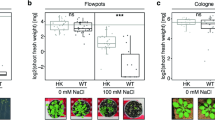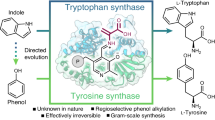Abstract
THE xylem formed on the upper side of arborescent angiosperms in reaction to inclination is often of the abnormal tension wood type. A complete discussion of tension wood anatomy is given in a recent review by Wardrop1. In brief, it is characterized by the presence of a large number of thick-walled, ‘gelatinous’ fibres of unusually low lignin content, and a reduction in the size and number of vessels over that of normal wood.
This is a preview of subscription content, access via your institution
Access options
Subscribe to this journal
Receive 51 print issues and online access
$199.00 per year
only $3.90 per issue
Buy this article
- Purchase on Springer Link
- Instant access to full article PDF
Prices may be subject to local taxes which are calculated during checkout
Similar content being viewed by others
References
Wardrop, A. B., The Formation of Wood in Forest Trees, 405 (Academic Press, 1964).
Wershing, H. F., and Bailey, I. W., J. For., 30, 411 (1942).
Fraser, D. A., Ecology, 33, 259 (1952).
Nečesaný, V., Phyton, 11, 117 (1958).
Berlyn, G. P., Iowa State J. Sci., 35, 367 (1961).
Audus, L. J., Plant Growth Substances, 80 (Leonard Hill, 1959).
Larson, P. R., The Formation of Wood in Forest Trees, 345 (Academic Press, 1964).
Author information
Authors and Affiliations
Rights and permissions
About this article
Cite this article
KENNEDY, R., FARRAR, J. Induction of Tension Wood with the Antiauxin 2,3,5-Tri-iodobenzoic acid. Nature 208, 406–407 (1965). https://doi.org/10.1038/208406a0
Issue Date:
DOI: https://doi.org/10.1038/208406a0
This article is cited by
-
Gibberellin-induced formation of tension wood in angiosperm trees
Planta (2008)
-
Relation between developmental changes on anatomical structure and on protein pattern in differentiating xylem of tension wood
Journal of Wood Science (2000)
-
7. The role of plant growth regulators in forest tree cambial growth
Plant Growth Regulation (1987)
-
The initiation of Xylem differentiation
The Botanical Review (1969)
-
Formation and function of compression wood in gymnosperms. II
The Botanical Review (1968)
Comments
By submitting a comment you agree to abide by our Terms and Community Guidelines. If you find something abusive or that does not comply with our terms or guidelines please flag it as inappropriate.



